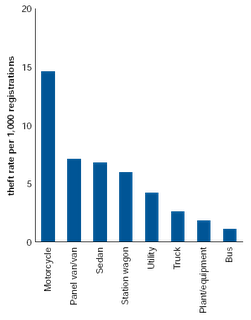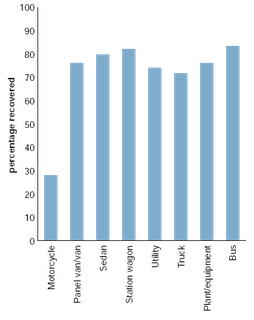|
posted by transport blogs
@ 10:09 PM
permanent link | |
0
comments

posted by transport blogs
@ 10:25 PM
permanent link | |
0
comments

- When buying a car, check the manufacturer's list of anti-theft options, such as interior hood and trunk releases, locking steering columns, and others.
- Consider the purchase and installation of security devices such as:
- Electric windows/doors.
- Electronic key.
- Keypad access.
- Steering wheel lock.
- Interior hood lock and release.
- A starter interrupt switch, or "kill switch", which prevents electrical current from reaching coil distributor, or a fuel switch which prevents fuel from reaching the carburetor.
- A locking gas cap.
- Locking devices for batteries, wheels, decks, etc.
- An alarm device which will activate a siren, horn, or lights -- or all three -- to frighten the thief away before he is able to steal your car. Avoid a security system with an override feature.
              
posted by transport blogs
@ 9:54 PM
permanent link | |
0
comments

 Rate of theft by type of vehicle, 2003-2004 Rate of theft by type of vehicle, 2003-2004Over the past four years the rate of stolen motor vehicles has declined significantly. In 2003-04 there were 88,030 vehicles stolen in Australia. Not unexpectedly trucks, plant/equipment and buses were the least likely to be stolen. Motorcycles were more likely to be stolen than any other type of vehicle, with a theft rate of 15 per 1,000 registrations, followed by vans, sedans and station wagons. Not only were motorcycles the most likely to be stolen they were also the least likely to be recovered; only 28 percent of stolen motorcycles being recovered during the course of the year.  Percentage of stolen vehicles recovered, by type of vehicle, 2003-2004 Percentage of stolen vehicles recovered, by type of vehicle, 2003-2004The percentage recovered for the remaining types of vehicles ranged from 72 percent for trucks to 83 percent for buses. There are also significant differences in the rate of theft for older and newer vehicles. Those manufactured in the 1980s recorded a theft rate of 14 thefts per 1,000 registrations compared with four thefts for 1990s models and three for 2000-2003 models. The recovery rates for older vehicles were higher than for more recent models. Of those vehicles manufactured in the 1980s, 83 percent were recovered, compared with 71 percent recovered for 1990s models and 60 percent for 2000-2003 models.
              
posted by transport blogs
@ 9:31 PM
permanent link | |
0
comments

The following tips help prevent vehicle break-ins, which could lead to theft of the vehicle itself or of property items from the vehicle. - Park in open, well-lighted, and populated areas near your destination. Avoid parking near trucks, vans, dumpsters, and other objects that obstruct visibility and provide hiding places. Avoid parking near strangers loitering or sitting in vehicles.
- Park in lots or garages where you don't have to leave your keys.
- Park in your garage, if you have one. Don't leave your vehicle on the street, in an alley, or on your driveway. If you have to park on a street, avoid dark or isolated areas.
- Turn off your engine, roll up all windows, lock all doors, and take your keys with you even if you are making a quick stop at a store or gas station, or even in your driveway. Close all windows and lock the trunk and hood.
- Don't leave spare keys in your vehicle. An experienced thief knows all the hiding places. Store spare keys in your wallet.
- Don't leave your vehicle in an unattended public lot for an extended period time.
- Buy a vehicle with interior hood and truck lock releases. Install a secondary hood lock if your car does not have one.
- Replace knob-type door lock buttons with tapered ones.
- Install an alarm system that will sound when someone attempts to break in, move, tilt, or start your vehicle. Always activate the system when leaving the vehicle.
- Check your vehicle if you hear the alarm sound. But don't try to stop a person attempting to break in. Get a good description of the person and call the police.
- Lock your vehicle with the door lock button inside your vehicle instead of with your remote control. Thieves are now able to pick up the signals from your remote when you lock your vehicle with it.
              
posted by transport blogs
@ 10:39 PM
permanent link | |
0
comments

Always lock your bicycle when you leave it Avoid leaving your bike in isolated places. Leave where the public can see it, however try not to leave on public display for long periods- even if locked properly Use a bike stand or shed if there is one available Lock your bicycle through the frame using two 'sold secure' approved security devices Secure or remove wheels - secure removable parts; lock both the wheels and the frame together and remove smaller parts and accessories that cannot be secured Lock your bike to an immovable object, such as a bike rack or ground anchors. Thieves can remove drainpipes and lift bikes off signposts Make the lock and bike hard to manoeuvre when parked. Stop thieves smashing it open by keeping the lock away from the ground. Keep the gap between bike and lock small Take out insurance on your bike, either by extending your home contents insurance or by creating a separate policy. Cycling organisations and bike shops may offer specialist cover Security mark the frame Take a photograph of your cycle and keep it safe Make a note of the serial number, make and model and keep it with the photograph of the cycle
              
posted by transport blogs
@ 10:12 PM
permanent link | |
0
comments

An anti car crime campaign has been launched by the Crewe & Nantwich Borough Council's Community Warden Team, Cheshire Police and the Safer Communities Partnership to put the brakes on car thieves. This follows the withdrawal of support for the existing scheme from the Home Office.
All motorists are being urged not to tempt thieves by leaving valuables on display and to be extra vigilant and remove valuables and other personal possessions from their vehicles.
Whilst out patrolling the borough the Community Wardens will be on the lookout for valuables left unattended in vehicles. The registration details will be taken of any vehicle found with items left unattended. This information will then be passed onto the Police, who will advise the Wardens of the vehicle owner's address. The Wardens will then issue an advisory letter and Vehicle Crime Prevention Leaflet to the registered keeper.
Belongings such as mobile phones, handbags, lap top computers, CD players and satellite navigation kits are on thieves' 'most wanted' list, with shopping bags also becoming a firm favourite. Motorists are failing to remove devices from windscreens and dashboards - which make easy pickings for opportunist thieves.
Portfolio Holder for Safer Communities, Councillor Rachel Bailey said: 'We are encouraging all car owners to remove any valuables on display in their vehicle, as this is proven to drastically reduce the likelihood of a theft being committed. Just a few minutes spent placing personal items in the boot or removing them from your vehicle may prevent a ruined day out. I know only too well how upsetting and distressing it is to discover your car has been broken into and the inconvenience it causes'.
Mark Cotton, Crime Reduction Advisor for Cheshire Police agreed that lack of care by drivers was a problem. "The Community Wardens, Parking Attendants, Home Watch and the CCTV centre all work together with the police to combat vehicle crime, and if the Wardens and attendants see drivers being careless about security they will talk to the driver reducing car crime and send them an educational letter. The ultimate aim of this initiative is to reduce car crime and the effect on vehicle owners".
Another aspect of vehicle crime in which the Wardens are involved, in partnership with the DVLA, is the reporting of unlicensed vehicles. On average 25 vehicles a month, which have been illegally driving around on the borough's streets without excise licenses, have been reported.
              
posted by transport blogs
@ 10:07 PM
permanent link | |
0
comments

posted by transport blogs
@ 9:28 PM
permanent link | |
0
comments

Section 511(a) of Title 18 makes it a felony knowingly to remove, obliterate, tamper with, or alter an identification number for a road motor vehicle or a road motor vehicle part. Section 511(b) of Title 18 creates exceptions for certain persons who engage in lawful conduct that may result in removal or alteration of an identification number. The legislative history is abundantly clear that subsection (b) is not intended to create a loophole for the operators of "chop shops." See H.R.Rep. No. 1087 on H.R. 6257, 98th Congress, 2d Sess. 23-25 (1984).
Section 511(c) of Title 18 contains the definitions for "identification number," "motor vehicle," "motor vehicle demolisher," and "motor vehicle scrap processor." The term "identification number" means a number or symbol that is inscribed or affixed for purposes of identification under chapter 301 and Part C of subtitle VI of Title 49.
Title 49, Chapter 301 authorizes the Secretary of Transportation to promulgate motor vehicle safety standards. Pursuant to this authority, Federal Motor Vehicle Safety Standard No. 115-Vehicle Identification Number (49 C.F.R. §§ 571.115 and 565.1 to 565.5) requires public VIN numbers on road vehicles (passenger cars, multipurpose passenger vehicles, trucks, buses, trailers, and motorcycles). Part C of subtitle VI of Title 49 (49 U.S.C. § 33101 et seq.) authorizes the Secretary of Transportation to promulgate theft prevention (parts marking) standards. The parts marking regulations are set forth in 49 C.F.R. Part 541. The mandatory component identification requirement applies to certain high theft passenger car lines starting with model year 1987. In 1995, the theft prevention (parts marking) standard was expanded to include certain multipurpose passenger vehicles and certain non high theft lines beginning with model year 1997.
              
posted by transport blogs
@ 9:53 PM
permanent link | |
0
comments

Roads Minister Stephen Ladyman today unveiled a new weapon in the fight against car crime. The new initiative involves number plates which are resistant to theft, making them less attractive to criminals and helping to combat car cloning and car ID theft. According to police data, an estimated 33,000 number plates were stolen during 2004, with many more thefts going unreported. Many of these plates are subsequently used to disguise vehicles used in serious criminal activity. New research shows that stolen plates are used to: * 'clone' stolen vehicles for re salei * conceal the identity of drivers involved in criminal activity (e.g. stealing fuel from petrol stations) * evade traffic related fines including parking tickets, speeding fines and congestion charges Stephen Ladyman said: "This is good news for law abiding motorists and the police and bad news for criminals. These new anti-theft plates will help to reduce the number of innocent drivers who receive fines for something they did not do and who have the stress of proving their innocence. They will also help to reduce vehicle cloning where stolen vehicles are sold on to unsuspecting motorists, and tackle the problem of petrol station 'drive offs' as criminals will no longer be able to hide behind stolen plates." DVLA has worked with number plate manufacturers to agree an industry standard for 'anti theft' plates. This now allows manufacturers to bring DVLA approved theft resistant number plates to market. Plates will only meet the standard if they cannot be removed within three minutes or cannot be reused after removal. Meredith Hughes, Chief Constable of South Yorkshire Police and Head of ACPO Road Policing said: "Number plate theft appears to be a growing problem. It is a crime in its own right, but also leads to further criminality as stolen plates can be used to disguise vehicle identity. DVLA's initiative to promote theft resistant number plates is welcome." Frank Whiteley, Chief Constable of Hertfordshire Constabulary and lead member of ACPO agrees: "I support DVLA's adoption of a standard for theft resistant number plates. If the industry takes up this challenge and more secure number plates become readily available, it should help to reduce this criminal activity."
              
posted by transport blogs
@ 10:30 PM
permanent link | |
0
comments

The National Highway Traffic Safety Administration's (NHTSA) original mandatory component identification standard for high theft "passenger car" lines became effective on April 25, 1986. The original standard was not applicable to vans, trucks, motorcycles, trailers, buses, or low theft passenger car lines, nor did the original standard cover any component on a 1986 or prior model year vehicle. Once a "passenger car" line became subject to the standard, coverage continues until the line ceases to be manufactured, or the line receives a "black box" exception pursuant to 49 C.F.R. § 543 from NHTSA because of additional anti theft features that the car contains as standard equipment. As new "passenger cars" were introduced, NHTSA would make a determination as to which would likely be high theft lines, and such lines became subject to the theft prevention (parts marking) standard.
The Act of 1992 expanded the universe of vehicles subject to parts marking. The new standard extends to "passenger motor vehicles," including certain multipurpose passenger vehicles, except light duty trucks, and extends to not more than 50% of the lines not designated as high theft lines. The current parts marking regulations appear at 49 C.F.R. Part 542 et seq.
The mandatory standard now covers these eighteen components and their replacements on the covered passenger motor vehicle lines: (1) engine; (2) transmission; (3) right front fender; (4) left front fender; (5) hood; (6) right front door; (7) left front door; (8) right rear door (if present); (9) left rear door (if present); (10) sliding or cargo door(s); (11) front bumper; (12) rear bumper; (13) right rear quarter panel (passenger cars); (14) left rear quarter panel (passenger cars); and (15) right side assembly (MPVs); (16) left side assembly MPVs); (17) pickup box, and/or cargo box LDTs; (18) rear door(s); (both doors in case of double doors) decklid, tailgate, or hatchback (whichever is present). In most cases the full 17 character VIN of the vehicle itself must be placed on the original component. While the number can be stamped into the component, most manufacturers are applying a counterfeit resistant label that contains the VIN. The label will self-destruct if it is removed. The number is to remain with the component until the component ceases to exist.
New replacements for the required components must contain the registered trademark of the manufacturer, the letter "R" to indicate "replacement," and the letters "DOT" which reflects the manufacturer's certification of compliance with the mandatory standard. Only the components originally attached to a car will contain a specific VIN, which, as mentioned above, will be the VIN assigned to the particular passenger car to which the component was attached.
              
posted by transport blogs
@ 9:53 PM
permanent link | |
0
comments

The goals of this report are:
To update the detailed statistics on motor vehicle theft and recovery presented in the 1991 report. For this report, theft and recovery data were available from 1984 through 1995, and insurance data from 1986 through 1992.
To revisit the evaluation of parts marking and antitheft devices, now that extensive data are available on the theft experience of cars with those remedies. (However, since theft data were available only through 1995, the effectiveness of the 1992 Act as regards expanded coverage in 1997 and later models cannot be analyzed at this time.)
To evaluate other provisions of the 1992 Anti Car Theft Act and the 1984 Act, focusing on changes that have occurred since the 1991 report.
The basic reasons for stealing cars have not changed since the 1991 report. Cars are stolen for transportation, joyriding, export, for repair parts, and to obtain expensive items such as stereo equipment for a quick profit. Since the last report to Congress, a new type of auto theft crime has emerged -- carjacking -- but the theft motives are still the same. Fundamentally, though, two types of auto theft may be recognized: (1) Professional thefts for profit, such as thefts to supply chop shops, retagging and retitling, or for illegal export. These thefts often result in a total loss to the original owner, but there is hope they can be deterred by remedies such as parts marking. They are believed to account for at least 23 percent of all thefts, and perhaps substantially more. (2) Nonprofessional thefts for purposes such as joyriding or to obtain temporary transportation. The vehicles are mostly recovered; on the other hand, parts marking would not appear as likely to deter these thefts.
Overall theft and recovery statistics: As in the 1991 report, theft and recovery data come from the FBI's National Crime Information Center. The data do not indicate the motives for individual thefts or separate the "professional" from the "nonprofessional" thefts. Analyses based on aggregate data cannot identify the effectiveness of each subsection of the 1984 and 1992 Acts, but can provide insights on the trend in thefts and recoveries.
The principal finding of this evaluation is that the auto theft problem, which was growing during the mid 1980's, leveled off or even began to decline after 1989-90. In 1995, there were 1,180,000 motor vehicles stolen, a decline of seven percent from the all-time peak of 1,270,000 experienced in both 1990 and 1992. However, the 1995 thefts are still 39 percent more than the 830,000 experienced in 1984. The theft rate per 100,000 registered vehicles increased from 543 in 1984 to 714 in 1990, but had dropped back to 597 by 1995.
Passenger cars account for 71 percent of all motor vehicle thefts, followed by light trucks - pickup trucks, sport utility vehicles and vans - at 24 percent. The remaining thefts are split between heavy trucks and motorcycles. Theft rates for all four vehicle types have declined since 1990.
Recoveries of stolen vehicles have kept pace with thefts over the years - recovery rates have remained stable at close to 80 percent of thefts throughout 1984-95. Passenger cars have slightly higher recovery rates than light trucks. Motorcycles have substantially lower recovery rates, and they have gotten worse. It is estimated that the annual economic loss resulting from vehicle thefts - and from the fact that many vehicles are never recovered or only recovered in a damaged condition - is at least $4 billion and could be as high as $8 billion.
Effect of parts marking and : The average consumer cost of parts marking in 1995 models was $4.92 per car. At that cost, just a 2 percent reduction in the theft rate would create consumer benefits exceeding the cost of parts marking.
Theft and recovery rates for car lines that got parts marking in 1987 were compared to the rates for the same car lines before 1987 and to the rates for car lines that did not get either parts marking or antitheft devices. However, the fact that, originally, only high-theft car lines got parts marking resulted in biases in the data that made it essentially impossible to reliably attribute a specific percentage reduction in thefts or increase in recoveries to parts marking. Still, the analyses provided five indications (hedged with caveats) that parts marking quite possibly had beneficial effects at times, apparently greater than 2 percent:
There was a conspicuous shift in theft rates in model years 1986-87, coinciding with the introduction of parts marking. Cars with marked parts had lower theft rates than expected, while those with unmarked parts had higher rates than expected. The effect was as strong as 20 percent when cars were new, but it weakened as they became older and seemed to have vanished by the time they were two years old. The latter is a noteworthy finding, since it is consistent with the view that many professional thieves subsequently learned how to obliterate the markings, and found them less of a deterrent.
Recovery rates for 1987 cars with marked parts were consistently higher than for corresponding 1986 models, even as the cars got older. However, this favorable effect in model year 1987 consistently deteriorated in later model years.
In calendar year 1987, the unrecovered-theft rate of model year 1987 cars with parts marking was 26 percent lower than expected. As the model year 1987 cars got older, the benefit diminished, but still persisted at about 6 percent. However, the latter estimate is within the "noise range" of possible biases in the data and it cannot be attributed to parts marking without considerable doubt.
Almost all car lines had lower theft rates in their early 1990's models than in their late 1970's models. However, the long-term reduction was substantially greater in the car lines that got parts marking or antitheft devices than in the car lines that did not. It is not so clear what happened during the crucial intervening years, the 1980's.
There was a strong reduction after 1987 in the percentage of vehicles that were only recovered in-part - i.e., missing their engine, transmission or a major body part (those which for high theft lines are required to have markings). There was a corresponding increase in percentage of vehicles recovered in-whole (no major parts missing) or intact. This trend was especially strong in the car lines with marked parts.
By contrast, for at least one type of factory-installed antitheft device, the available data unequivocally show effectiveness. The system installed by a domestic manufacturer as standard equipment in various car lines during 1989-94 was associated with an immediate, and persistent 70 percent reduction in the theft rate and a 58 percent reduction in the unrecovered-theft rate. This device appears to be quite effective in reducing both "professional" and "casual" thefts. Of course, a system of this type has a far higher cost than parts marking.
Fewer data were available on the antitheft devices factory-installed by other manufacturers. Specific estimates were not obtained, but there appeared to be considerable variation in effectiveness. With some of the devices, little change was seen in theft rates; with others, there were reductions comparable to those for the domestic manufacturer. No data were available for evaluating the effect of aftermarket antitheft devices.
On the whole, the analysis results seem to suggest that the approach of Chapter 331 of the Anti Car Theft Act, which views both parts-marking and factory-installed antitheft devices as effective deterrents to automobile theft, has had benefits. There is some indication that the effect of parts marking might have been greater than two percent needed for cost-effectiveness, at least at certain times. Parts marking and antitheft devices have complementary roles: antitheft devices make it harder to steal a car, while parts marking deters professional thieves because it makes it easier to apprehend and convict them. The two remedies seem to be integral components of a larger program to combat auto theft. That program has, on the whole, had an impact, as evidenced by the leveling off and reduction of theft rates after 1990.
Discussion of other provisions of the 1984 and 1992 Acts: Collection and dissemination of theft and recovery information has improved since 1991, primarily because technical advances in communications and computer equipment made databases more complete and accessible to agencies needing the information. The two systems called for in the Anti Car Theft Act of 1992 - the National Motor Vehicle Title Information System and the National Stolen Auto Part Information System - are either not completely in place or are so new that their effects on vehicle theft (prevention, recovery or apprehension of thieves) cannot be evaluated at this time.
In tandem with the number of motor vehicle thefts, arrests for auto theft peaked in 1989 and have leveled off since then. In 1994, an estimated 200,000 were arrested for auto theft or attempted theft in the United States.
While recent surveys of district attorneys and law enforcement agencies did not provide detailed statistical data on arrests, prosecutions, and convictions for , they present an even more encouraging picture than corresponding surveys in the earlier report. Since 1991, there have been moderate increases in the number of prosecutions under both Federal Acts. There have also been increases in the level of effort directed to each prosecution. Now that they have better evidence with which to work, both prosecutors and officers are willing to invest more effort at obtaining a conviction. By 1996, prosecutors saw an increase of over 20 percent in the number of prosecuted cases, and 10 percent said that theft rates had declined in their jurisdictions. By 1996, in contrast to almost no effect seen in 1991, almost half of the district attorneys reported an increase in convictions - and most of them attributed it to the Federal Acts. Stiffer sentencing was occurring in 45 percent of the convictions, including a 75 percent increase in jail sentences. This could be even higher, they report, but for prison overcrowding.
Law enforcement agencies report the same attitudes about the deterrent effects of parts marking in 1996 as they did in 1991. They feel that auto thefts for chop shop operations will continue if there is a demand for a part, marked or not. But almost half of the investigators feel that parts marking makes professional thieves more cautious or even deters them completely from stealing cars with marked parts. All investigators thought parts marking had no effect on amateur thieves. Parts marking seems to have the greatest effect on chop shop operators because of the increased cost of "doing business."
Auto theft investigators feel that parts marking is a valuable tool for arresting and prosecuting thieves. In 1991, they saw little or no effect, but by 1996, most of them felt that parts marking did assist in identifying and recovering stolen parts and vehicles. About three fourths of the law enforcement agencies in big cities said parts marking helped in arresting both chop shop operators and professional thieves. Auto theft investigators, as in 1991, still say that more permanent methods for parts marking are needed. Even though it is unlawful to remove labels from marked parts and the labels are required to leave evidence that they were once on the marked part, thieves have found methods for removing both the label and its "footprint". The investigator then has to be sufficiently knowledgeable to recognize that the part should have a label. Also without the label it is very difficult to trace the part back to the vehicle from which it was stolen.
Data received from the Customs Service since the 1991 report, indicates it has improved its ability to recoup stolen vehicles.
Insurance companies have not reported any effects of parts marking on insurance premiums. Some insurance companies do offer discounts on comprehensive premiums for vehicles equipped with certain types of anti theft devices. Analysis of claim payments also has not shown any specific effects of either parts marking or antitheft devices. Insurance companies report that their used part policies have not changed since 1986. About three fourths of the reporting companies encourage the use of used parts for crash repairs. Most companies rely on the repair shops to obtain parts from reputable sources.
In conclusion, it appears that parts marking and other provisions of the 1984 and 1992 Acts have given the law enforcement community tools they can use to deter thefts, trace stolen vehicles and parts, and apprehend and convict thieves. Theft rates leveled off after 1989-90 and have begun to drop. While the program to reduce auto theft has had an impact, there appear to be four areas with potential room for improvement: (1) Insurance companies and motor vehicle departments could take better advantage of the existing parts marking program by routinely requiring inspection of the markings of used parts acquired at body shops and used vehicles brought in for new titles. The current setup, where some models have parts marking and others do not, may discourage routine inspections. (2) To the extent that current parts markings can be obliterated, their long-term deterrent effect may be diminished. (3) Since many vehicles still do not have marked parts, the deterrent effect of parts marking at this time may be offset by increased thefts of the vehicles without marked parts. (4) Appropriate antitheft devices can substantially reduce all types of thefts, but are currently standard equipment on only a limited number of car lines. However, to the extent that antitheft devices and parts marking are complementary strategies, more extended availability of antitheft devices ought not come at the expense of eliminating parts marking. The best results are likely to be obtained when vehicles have both remedies.
              
posted by transport blogs
@ 10:06 PM
permanent link | |
0
comments

|
![]()
![]()










